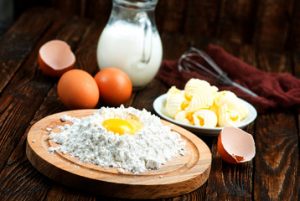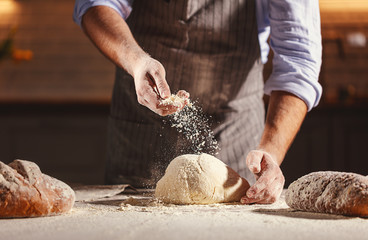Say those words and the image of burly men chugging questionably healthy protein shakes and lifting weights at a gym comes to mind immediately, but the status of protein powders as only a supplement to crazed health nuts and bodybuilders does these amazing products no justice. While shakes are popular, powders can be added to popular baking recipes such as muffins and pancakes as part of a healthy diet.
Why Use Protein Powder?
Protein powders are especially useful for older teens and people on vegetarian or vegan diets. Teenagers need more protein as their bodies grow, especially if they are athletic, and it is difficult to get a healthy amount of whole proteins (those that contain all nine amino acids the body needs) elsewhere if animals or animal byproducts are cut out of a diet. However, anyone can incorporate protein powders into their baking. Try incorporating these tips if you are starting a new exercise regimen or take a long time recovering from injuries– both of these indicate that you need more protein– or if you are simply looking to replace some carbs in your diet with protein.
Vegan vs. Non-Vegan Protein powder

For the purpose of this article, there are two kinds of protein powder: Vegan and non-vegan. Whey, a milk-based protein, is the most popular, and it’s a non-vegan powder. (Obviously– it’s milk-based!) Other common non-vegan powders include casein and egg. Meanwhile, plant-based powders such as hemp, soy, pea, and rice are all vegan and are used quite differently. Be sure to consult a substitution chart, like this one courtesy of Protein Pow, when you’re reading a recipe and intend to substitute one powder for another.
Baking With Protein Powders

Baking with protein powders is not like regular baking, and if you treat it as such, you’ll end up with rubbery bread and disappointment. Each powder is used differently in baking, and most require a moisturizer to make a product that doesn’t feel like a hockey puck in your mouth. These powders are whey, casein, and any powder derived from a vegetable.
Examples of moisturizers in baking with protein powders include:
- Fruits (bananas, liquid strawberries, applesauce)
- Greek yogurt
- Cooked Beets
- Cottage cheese
- Quark
Anything liquid that will weigh down your powder base and add moisture to your food will most likely work as a moisturizer (except actual skin moisturizer… don’t use that). These examples are great starting points, but experimentation is key, and the ingredient used will vary by recipe. You would probably not use banana in a red velvet recipe, for example, nor Greek yogurt in banana bread.
Binding agents are necessary for lots of recipes, but when you are substituting a portion of your flour for a protein powder, they become essential. Additionally, the most common binding agent (eggs) cannot be used by vegans, who need alternatives in all their baking but especially protein powder baking.
Examples of binding agents other than eggs include:
- Xanthan gum and Guar gum
- Unflavored gelatin
- Superfine flax seed meal
- Nut butter
Most binding agents other than eggs require some specific knowledge to use, which can be found alongside more alternatives here thanks to Alea at My Real Food Life.
General tips and tricks for baking with protein powder
When measuring out how much powder to add, it’s important that your protein makes up absolutely no more than half of the total dry ingredients, and even less for whey or casein, which should be as close to 1/4th of the total as you can manage or the final product will be dry and sad.
If you use egg powder, you MUST reconstitute it, which essentially means turn it back into an egg white by adding liquid. It’s simple, but if you forget, your baked good will be a baked bad.
When baking protein cookies, remember to use a fat, unless you’re going for a concrete-like consistency.
Bake Responsibly, Be Healthy
Watch how much protein you consume, from shakes, bread, or otherwise. Baking with these powders is a great way to supplement a new or more rigorous exercise routine, make up for lost proteins while on specialized diets, or help recover from an injury, but overloading your body with way too much protein can severely damage your kidneys and put you at risk for various health problems, so enjoy responsibly. On average, depending on how active you are, you should consume 0.8 to 1.8 grams of protein per kilogram of body weight per day.
Author’s Bio
Jennifer is the beauty and brains behind Beautifully Alive! She loves eating healthy and trying new recipes.The self-proclaimed Zumba Queen has a passion for beauty products and loves reading new books. She’s always down for a DIY project!
ALSO READ:
- The Ultimate Pegan Diet For Beginners
- 9 Healthy Smoothie Recipes With Almond Milk
- 6 Easy Low Carb Diet Recipes For Weight Loss








